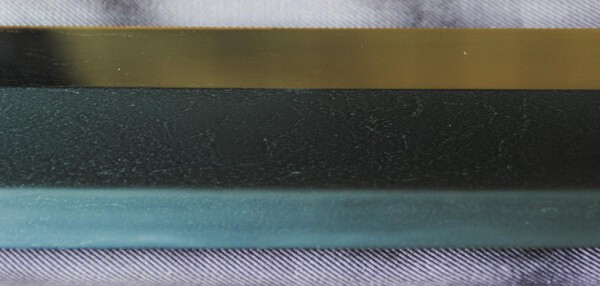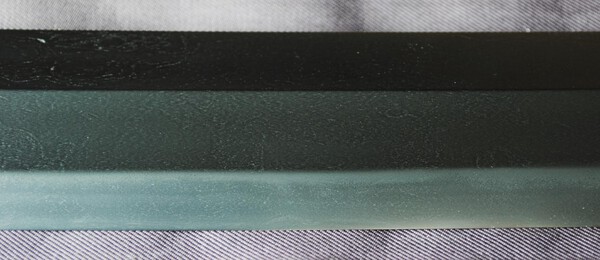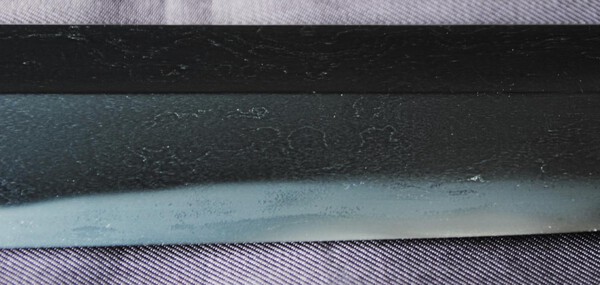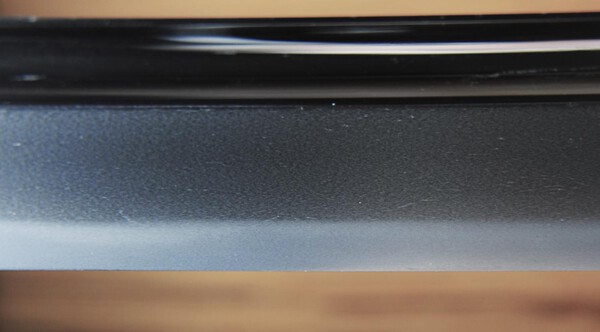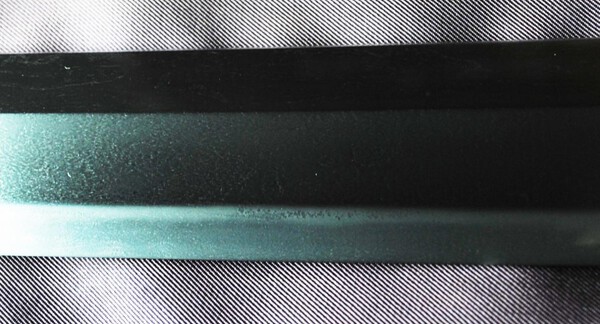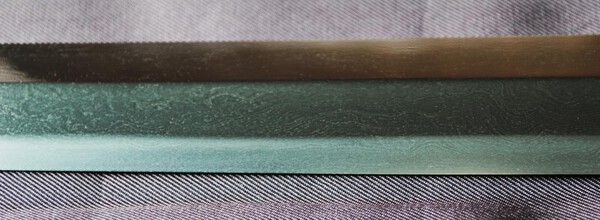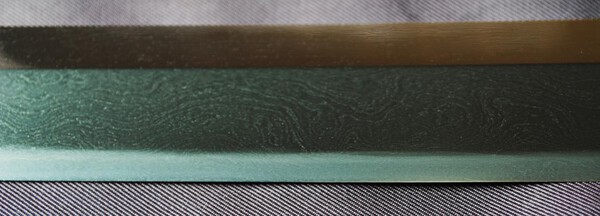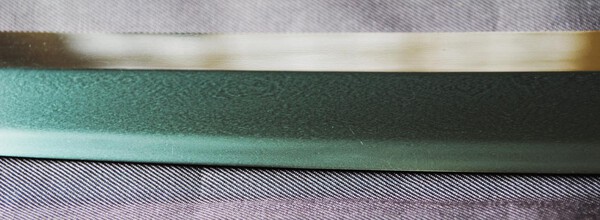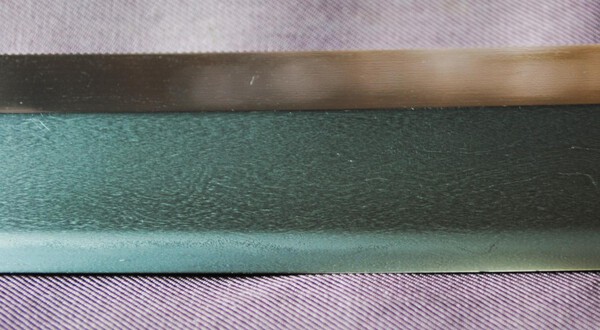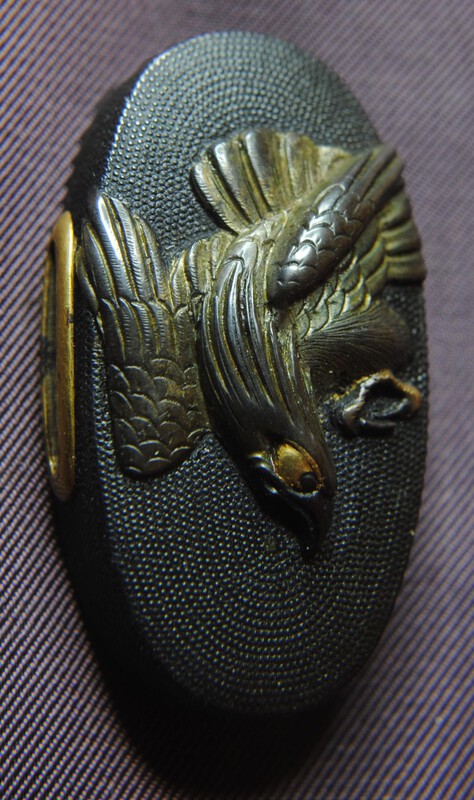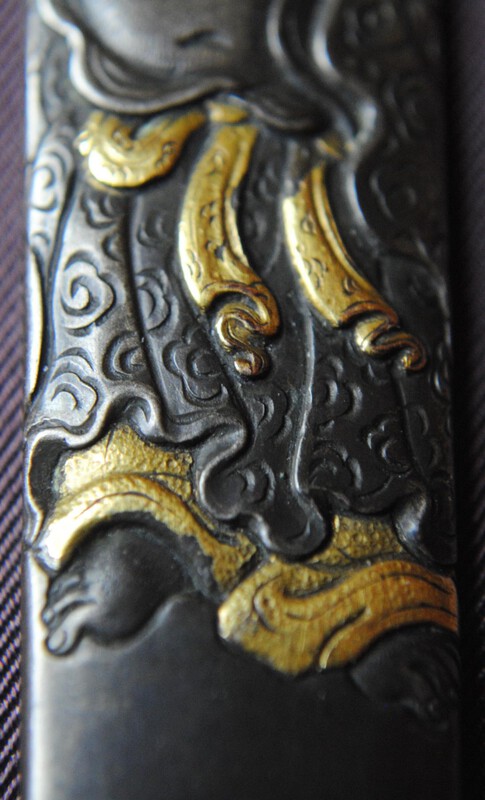-
Posts
3,046 -
Joined
-
Last visited
-
Days Won
73
Content Type
Profiles
Forums
Events
Store
Downloads
Gallery
Everything posted by paulb
-
Hi Kirill you must have read my mind 2 is too dark so I have added some more below: You are not far off in your guesses but my idea was less about trying to identify the school (as said you are pretty close) but more about deifning the hada you are seeing.
-
I just posted this on the Token of GB Facebook page and thought it might be of interest here as a small exercise. We often trip over describing different forms of hada and the more variations we look at the easier (hoepfully) it should become. We have done this before but on a day that is not much good for anything else I thought you might want to exercise your grey matter with a small recognition exercise. The attached images are from 4 different swords all I believe to be fairly representative of their schools. Rather than trying to jump straight in to attributing these to a school, which without a lot more information would be a lot of guess work, See how you would describe the hada you are seeing.
-
Sorry Kirill but I disagree more than a little about your statement re Enju vs Rai. I do not believe one can make such generalisations for any comparison. I have seen some very ordinary Rai blades, not only by second teir but even by such greats as Rai Kunitoshi. I have also seen stunning work attributed to Enju. The Best Enju blades I have seen could be easily mistaken for good Rai work (initially one I haver studied in detail was thought to be by Rai Kunimitsu). The telling difference was generally the boshi which in Enju pieces tends to be O-maru. Other than that the jigane, hamon and shape were very much in line with what would expect from good Rai work. I agree with Michael regarding colour it can only really be judged in comparison with something else. On the other side I have also seen some very plain and ordinary Enju pieces that didn't come close to Rai. In schools that span decades there is not a one size fits all assessment. Variation in quality within a school can often be as great or greater than between different but related schools.
-
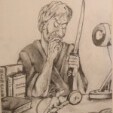
Juyo Biyutsu Den Mihara Masahiro
paulb replied to Fuuten's topic in Auctions and Online Sales or Sellers
Coming back to the debate. I like this sword very much (perhaps nor surprisingly consdiering my Aoe/Yamashiro/Yamato obsession) I have said in the past I have never seen a ko-Mihara blade with a bad shape, they always look elegant and in proportion. This one also enjoys beautiful Jigane and a lot of fine activity within the hamon so I can well understand why it is regarded so highly. -
Legally post war swords have to be made by a qualified smith and using traditional material and technique and are therefore Nihon-To. The debate/argument/ disagreements tends to be about those made just before and during WWII.
-
Hi Ken, the short answer is no I havent, mainly because I had never heard of it and have no idea what it does. At the moment I am bathing in total smugness that after probably 10 years I have finally worked out how to change a key feature on the camera. Going beyond the basic editing software in windows 10 may be a step too far and bring me swiftly back to reality
-

Kawachi Daijo/ Kuni Sada sword - opinions please
paulb replied to Dean1981's topic in Military Swords of Japan
Dean, The problem is you can see absolutely no detail in the blade. It looks clean and healthy but until it's polished you wont know. Kunisada is a good name, whether they mei is correct and which Kunisada it is I don't know. The fittings have been assembled at some point, part military and part not. If you buy it you would need to consider having it polished to get the most from it and possibly mounted in a shirasaya. At $1500 it is not an over expensive buy but only you can decide whether it gives you what you want at a price you are comfortable with. -
Hi Grev, Hawleys is an index of smiths and has little or no information about them other than their different mei and when they worked. I will see what I can find in other Hizen references
-
Dear All, Just to prove it is never too late to teach an old dog new tricks and thanks to your combined advice I have found out how to adjust the depth of field...... While still a long way below some of the excellent results often shown here I think I have made progress.
-
Thank you Uwe, you have gven me a lot to look at and think about much appreciated Paul
-
Thank you Ford I appreciate your advice I will have an explore and play Best Regards Paul
-
Hi Brian, Thank you and yes I agree they are beautiful. I admit to having had very little interest in fittings, I could look at hundreds of tsuba, and I did, without really feeling any of the appreciation I do for swords. When I do look I normally focus on iron tsuba but more recently started to look at soft metal. As you say the technique and skill levels are amazing. I also think the way the artists combine different alloys to such good effect is incredible. I think I may have started on the slippery slope to becoming a fittings enthusiast!!
-
Hi Ford I use a Nikon D3000 with the standard 55mm lens with a macro attachment (for some of them). Likewise I have a tripod and do use it (sometimes) According to the "dummies guide" I can change the depth of field but so far this dummy hasn't worked out how nor been able to follow their step by step instructions (I guess there are degrees of dummies and this caters for a higher level:-)) I really appreciate people taking their time to help and offer tips which I will find very helpful. I think the aim with these was really just to show the level of workmanship in particular areas rather than offer an illustration of the whole thing (but may be that's just an excuse!) Cheers Paul p.s. I hope you are continuing to recover and doing as you are told.
-

Interesting Pdf Articles And Links
paulb replied to Brian's topic in General Nihonto Related Discussion
no problem Brian and thank you for posting them -

Visiting Aoi Japan - First Nihonto Ever
paulb replied to radicalrad's topic in Auctions and Online Sales or Sellers
I am glad I have pretty well stopped collecting! Over the past thirty plus years I have bought pieces from and sold pieces to nearly all of the different dealers mentioned here and more. I may just have been very lucky but I have never had a bad expereince from any of them and now count many of them as friends. Today there seems to be an increasing lack of trust and good faith. I think it has a lot to do with the expansion of social media which allows unqualified hysteria to spread like a nasty rash. Ultimately we have to trust ourselves, buy what we like from a trusted source and enjoy it. At the risk of being contentious most problems appear to originate when people rely too heavily on what they are told rather than what they can see, they use a papering system as a shortcut or replacement for study and then panic if someone on social media says something negative about their purchase. Study ( knowledge and understanding increase confidence.), decide what you like and buy it if you are happy with the price. -
Thank you for the feedback and suggestions gentlemen it is much appreciated. I am afraid there is one vital element missing from my setup and that is patience! Combining the lack of this with incredible clumsiness does not make a good foundation to practice this art, but I shall persevere. Regarding the questions: Ken- I used a macro lens I also had lighting from the side as you suggested but probably could have improved the angle. Barry- I can understand why you thought it might be Ishiguro, I thought that when I first saw it. It is signed Hidefusa. I cant find him listed in any of my limited rferences but he is thought to be a follower of the Omori school. Kirill you are correct about both time (I have them around 1820) and the Kozuka is signed Noriyuki who is a listed Hamano artist.
-
I have spent many hours in the past trying to photograph sword blades. Over the past couple of days I have had a different challenge in attempting to accurately capture the fine detail on two recently purchased pieces. Results attached
-
Honest answer Neil is I dont know. There have been several examples of blades that under normal circumstances would be regarded as illegal suddenly appearing for sale on various dealers websites. However these odd exceptions do not make the basic hypothesis invalid. I do think there needs to be some revision and clarity but I doubt the Government would see it as a priority. Also I think there should be an authentication system for WWII swords, a different one to that used for traditionally made swords. Again I am not sure there is the political will to do it.
-
If they are made using traditional methods and materials then yes. If not they would be illegal, regarded as a weapon and not called much else than that I would guess. BTW what I am saying is what I understand to be the case based on what I have been told over the years but that doesn't necessarily make it right. It is opinion and interpretation rather than a statement of fact:
-
I am not sure this is as complicated as we appear to be making it. during the early occupation all swords were designated as weapons and illegal to own. Subesequently it was understood and accepted that pre-war swords were of historical and cultural importance. Such swords were defined as Nihon-To. They had to have been made using traditional techniques and materials. This excluded the vast majority of WWII blades which were regarded as weapons and of "no artistic value". Exceptions to this were blades made by qualified and registered smiths using tamahagane. These were described as Gendaito as opposed to gunto (army swords) which were made in factories using some of the many defined techniques. When sword manufacture was legalised in the 1950s it could only be practiced by smiths who had undergone a formal apprenticeship and registered. These were also called Gendaito. As far as I am aware the term shinsaku-To only came to the surface when Yoshindo Yoshihara first started to appear in the USA. Not sure where the term originated but the first references I ever saw related to his work. Bottom line is that for any sword to qualify as a Nihon-To (using the legal definition) it has to be made using traditional methods and material by a fully trained smith. All other terms koto, shinto etc related to periods of manufacture rather than methodology. Sorry if I am repeating myself and others but I think we are getting a bit tied up and confused between terms that relate to period of manufacture and those that refer to technique.
-
I think part of the confusion or differing of opinion in this really relates to the weapon vs art debate. There is absolutely no question that the first function of any blade, koto, shinto or Gendaito is that it should cut. If it fails in this primary requirement then it is not a good sword. End of discussion. However as can be seen in many examples from all periods, in some cases in creating a form to meet that function some smiths go far beyond the basic utilitarian requirement and produce something that is visually stunning. It combines shape, jigane and hamon in a way that far exceeds functionality and thus becomes an art sword. It is also true that such pieces while the original intent was to carry them as a weapon, very early in their history they were recognised as something far more important and valuable and cherished as art. Hence some of the better koto blades have survived 7-800 years in such good condition.
-
Think the reality is people will choose whichever definition suits them best. I have heard many people arguing that their gun to were every bit as good as koto blades, I would argue very strongly they aren't. But the fact is it is largely subjective and based on what you like and enjoy
-
Yes David you are absolutely right and Gendaito fall in to the legal definition. The problem comes with any blades using the 9+ other methods and combinations of materials used in making showa period blades. Re: smiths making their own steel they have been doing that throughout the koto period and as long as they made it using the right raw material, santetsu and in the traditional way it is still tamahagane. Centralised production of Tamahagane came in to effect under Hideyoshi but prior to that most Tamahagane was produced locally. I admit this is not my area of interest but as said the debate keeps cropping up. The real problem comes where there is uncertainty and such questions as "can swords with a showa stamp be Gendaito" occur. I have seen Showa blades with the 4 characteristics defined by Neil and with a showa stamp but they were not (or at least not classed as) true Nihon-To.
-
Neil, I think this subject has been debated to death but keeps coming back. A True Japanese sword is not defined by your4H's. According to the original legal definition a sword can only be regarded as Nihon-To if made using traditional methods and material i.e. Tamahagane (at least in part, some shinto smiths did combine it with foreign steel). However once a sword is made it is impossible to tell if it is made using tamahagane or not. Also a sword made using different steel can still to some extent exhibit hada and hamon (a function of forging rather than material). Re; Recognition of showa swords I think in a previous post I said that yes absolutely there should be a papering system for them, defining authenticity and quality but it should be a different one to that used for pre Showa work.


